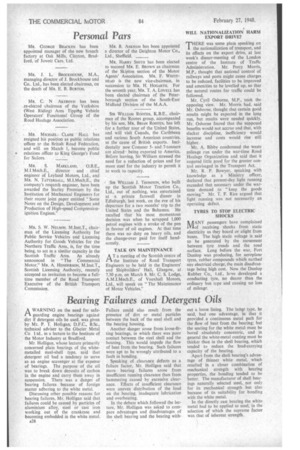Bearing Failures and Detergent Oils
Page 30

If you've noticed an error in this article please click here to report it so we can fix it.
1-1 A WARNING on the need for safe guarding engine bearings against dirt if detergent oils be used, was given by Mr. P. T. Holligan, D.F.C., B.Sc., technical adviser to the Glacier Metal Co. ltd.. in a lecture to the Institute of the Motor Industry at Bradford.
Mr. Holligan, whose lecture primarily concerned plain hearings of the, whitemetalled steel-shell type, said that detergent oil had a tendency to serve as an engine scavenger at the expense of bearings. The purpose of the oil was to break down deposits of carbon in the engine and carry them away in suspension. There was a danger of bearing failures because of foreign matter adhering to the white metal.
Discussing other possible reasons for bearing failures, Mr. Holligan said that failures could be caused by particles of aluminium alloy, steel or cast iron working out of the crankcase and becoming embedded in the white metal.
A28
Failure could also result from the presence of dirt or metal particles between the back of the steel shell and the bearing housing.
Another danger arose from loose-fitting bearings, in which there was poor contact between the steel shell and the housing. This would impede the flow of heat from the bearing. Such failures were apt to be wrongly attributed to a fault in bonding.
Speaking of clearance defects as a failure factor, Mr. Holligan said that more bearing failures arose from insufficient running clearance than from hammering caused by excessive clearance. Effects of insufficient clearance were uneven distribution of the load on the bearing, inadequate lubrication and overheating.
In the debate which followed the lecture, Mr. Holligan was asked to compare advantages and disadvantages of the shell bearing and the bearing with
out a loose lining. The lattir type, he said, had one advantage, in that it provided a continuous metal path for the flow of heat from the bearing; but the seating for the white metal must be bored absolutely concentric, and in general the white-metal coating must be thicker than in the shell bearing, which tended to reduce the toad-carrying capacity of the bearing.
Apart from the shell bearing's advantage of thinner white metal, which resulted in a closer combination of mechanical strength with bearing properties, the bonding tended to be better. The manufacturer of shell bearings naturally selected steel,_ not only for its mechanical strength but also because of its suitability for bonding with the white metal.
In the directly cast bearing the white metal had to be applied to steel, in the selection of which the supreme factor was that of inherent strength.




















































































